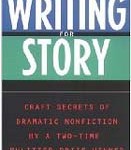
In teaching my Seattle writing class, I’ve learned that structure is the biggest challenge for most writers. While most writers understand sentence structure and paragraphing, they have trouble organizing individual paragraphs into a larger story. This is one of the things we’ll discuss in my upcoming spring Seattle writing class, Writing for Story. One of the best ways of structuring a story is to begin with an outline, one of the techniques I’ll discuss in my spring Seattle writing class, Writing for Story. This needn’t run pages and pages: sometimes even a simple three or four sentence outline can do the trick, such as the one I’ll explain below. By using this outline, whether for a story or book, you’ll have a good chance of figuring out the larger shape of the story in advance. If you fail to do this, it’s like building a house without a strong foundation; it can easily collapse.
The dramatic outline allows you to chart the emotional peaks and valleys of the story so that you’ll know where you’re heading when you sit down to write. The five short statements below describe the major actions in the story. There is one statement for each major focus. This is not like the outline you wrote in English composition class; these statements highlight on the dramatic actions in story. They help you focus on what’s essential to the story. This is a conflict—resolution outline, with the conflict introduced in the first statement, developed in the next three statements, and resolved in the last statement.
1) Complication – Make it simple and active. Have you chosen active verbs to show action? Is the main character included statement? How will you illustrate the main action? Do you have the source material for this? Is the action dramatic enough?
2) Development Action – Clear, cogent, related to complication.
3) Development Action – Clear, cogent related to complication, tied to previous development, tied to main character.
4) Development Action — Clear, cogent related to complication, tied to previous development, tied to main character.
For more: Writing for Story.
 The Writer's Workshop
The Writer's Workshop 











